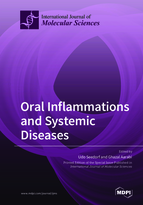Oral Inflammations and Systemic Diseases
A special issue of International Journal of Molecular Sciences (ISSN 1422-0067). This special issue belongs to the section "Molecular Pathology, Diagnostics, and Therapeutics".
Deadline for manuscript submissions: closed (31 May 2019) | Viewed by 82491
Special Issue Editors
Interests: biomarkers; cardiovascular disease; caries dental disease prevention; endodontic lesions; genome-wide association studies gingivitis; intima media thickness periodontitis; oral microbiome surrogate markers; systems medicine
Interests: autoimmunity; autonomous nervous system; cerebral small vessel disease; coronary heart disease; diabetes; epidemiology; genome-wide association studies; genomics; inflammation; ischemic stroke; metabolomics; microbiomics; oral-brain axis; peripheral arterial disease; proteomics; systems medicine; transcriptomics
Special Issue Information
Dear Colleagues,
Oral infections occur frequently in humans and often lead to chronic inflammations affecting the teeth (i.e., caries), the gingival tissues surrounding the teeth (i.e., gingivitis and endodontic lesions), and the tooth-supporting structures (i.e., periodontitis). It has been proposed that these inflammations are not restricted to their specific sites in the oral cavity, but that they may have a negative impact also on the general health of the affected patients via increasing their risk for several widespread diseases, such as diabetes, coronary heart disease, peripheral arterial disease, ischemic stroke, and small vessel disease in the brain. At least four basic pathogenic mechanisms have been proposed that involve oral inflammations in the pathogenesis of these widespread diseases: (1) low level bacteremia, by which oral bacteria enter the blood stream and invade the body; (2) systemic inflammation induced by inflammatory mediators released from the sites of the oral inflammation into the blood stream; (3) autoimmunity to host proteins caused by the host immune response to specific components of oral pathogens; and (4) pathogenic effects resulting from specific bacterial toxins that are produced by oral pathogenic bacteria.
This Special Issue focuses on several aspects of the interaction between oral infections and widespread systemic diseases, and we invite contributions of reviews and/or original papers reporting recent efforts in this field.
Dr. Ghazal Aarabi
Prof. Dr. Udo Seedorf
Guest Editor
Manuscript Submission Information
Manuscripts should be submitted online at www.mdpi.com by registering and logging in to this website. Once you are registered, click here to go to the submission form. Manuscripts can be submitted until the deadline. All submissions that pass pre-check are peer-reviewed. Accepted papers will be published continuously in the journal (as soon as accepted) and will be listed together on the special issue website. Research articles, review articles as well as short communications are invited. For planned papers, a title and short abstract (about 100 words) can be sent to the Editorial Office for announcement on this website.
Submitted manuscripts should not have been published previously, nor be under consideration for publication elsewhere (except conference proceedings papers). All manuscripts are thoroughly refereed through a single-blind peer-review process. A guide for authors and other relevant information for submission of manuscripts is available on the Instructions for Authors page. International Journal of Molecular Sciences is an international peer-reviewed open access semimonthly journal published by MDPI.
Please visit the Instructions for Authors page before submitting a manuscript. There is an Article Processing Charge (APC) for publication in this open access journal. For details about the APC please see here. Submitted papers should be well formatted and use good English. Authors may use MDPI's English editing service prior to publication or during author revisions.
Keywords
- Autoimmunity
- Bacterial toxins
- Biomarker
- Cancer
- Cardiovascular disease
- Cytokines
- Diabetes
- Endodontic lesions
- Gingivitis
- Inflammation
- Oral microbiome
- Oral–brain axis
- Periodontitis
- Stroke
- Systemic inflammation







